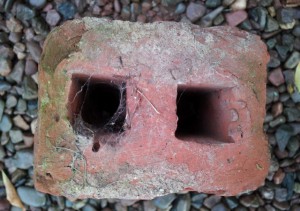
These pencil or whistle drains were found by Ian Suddaby.
They were found in 2003 at Longhaven near Peterhead. Cruden Bay Brick and Tile Works was a few miles away but where the pipes were made is unknown.
Although they did not contain water when found in the autumn, the drains appeared to be unblocked. It is thought, that in these very narrow drains, the water flow may thus be faster than in a ‘normal’ sized drain and thus not as prone to blocking with silt etc.
The tiles measure approx 12″ long x 1″ inside diameter and 1½” outside diameter although all these measurements can vary by a good 1/8″ depending on where you measure.
.

.

“The Industrial Archaeology of Farming in England and Wales” by Nigel Harvey … “Pipes of 1” diameter, the smallest used, can also be dated within two or three decades for they provide an interesting relic of technical failure. They were produced in the belief that a small bore would increase the speed of the water flowing through them and so keep them clear. Unfortunately, the engineers had underestimated the drag factor, which slowed the movement of the water and therefore increased the rate of accumulation of silt until the pipes choked. The period when these “pencil pipes” were used, therefore, was short from the 1840s to the 1870s when they were finally abandoned.”









